FC Dallas have a formidable reputation among American football academies. Most would agree that they are the country’s premier youth development club.
In recent years, they’ve produced Juventus‘s Western McKinney, Bayern Munich‘s Chris Richards, and a number of MLS’s top players, including Jesse Gonzalez, Victor Ulloa, Kellyn Acosta, Jesús Ferreira and Paxton Pomykal. Another academy product, Reggie Cannon, now plies his trade in the Portuguese Primeira Liga with Boavista.
As we enter the second half of the 2021 MLS campaign, it seems clear which player is next up on the FC Dallas academy conveyor belt. His name is Ricardo Pepi, an 18-year-old from El Paso, Texas who has become the focal point of the team’s attack.
Due to Bayern Munich’s cooperation agreement with FC Dallas, Pepi was one of six players invited to train with the Bavarian club for three weeks during the MLS offseason. Another player to earn that opportunity was Brian Reynolds, the 20-year-old right-back who recently signed for Roma.
This tactical analysis takes a look at Pepi, examining the skill set that has him among the league’s top scorers while playing a prominent role for Dallas’s first team. This scout report will first look at his data profile, showing how his playing style is a perfect fit for the club’s system. Then, we’ll look at his direct form of attacking, as well as his off the ball movement. Throughout the analysis, you’ll see the theme of clinical finishing, the clear top talent in Pepi’s repertoire.
Profile and system fit
Starting with Pepi’s data profile, we do see the inconsistencies of youth. He’s off the charts in some areas of his game while others are well behind the median among MLS forwards.
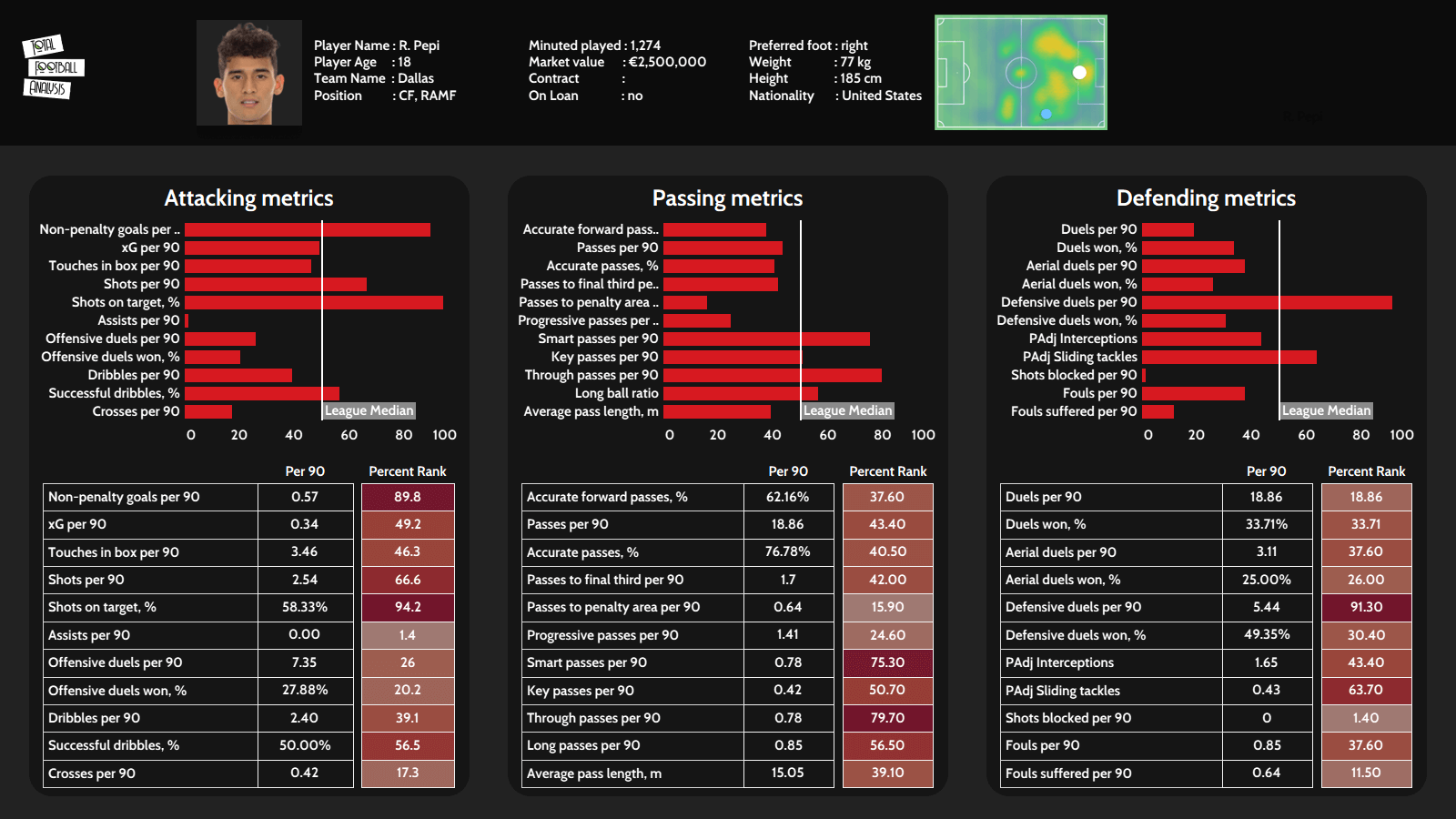
One interesting takeaway is that when he excels in a statistical category, he’s near the top of the charts. No quality is more impressive than his work in front of goal. While other areas of his game may waiver, he’s found a way to consistently put the ball in the back of the net in the 2021 campaign. He’s also among the league leaders in the percentage of his shots that reach the target, all while rating in the 67th percentile for shots per 90.
Looking at the passing and defending metrics, he rates highly in smart passes, through balls per 90 and defensive duels per 90. Those are very closely tied to Dallas’s intense high pressing and direct attacking moves towards goal.
The final area I’ll address here is his poor win rate in aerial duels, rating in the 26th percentile among MLS forwards. That 25% success rate in aerial duels gives an indication of his issues in fending off centrebacks, as he’s often outmuscled in the air.
That deficiency is also seen in his holdup play. One of the areas of his game that needs improvement Is his ability to hold off opponents when the ball is played into his feet. As he tries to hold the ball up, he often takes a high stance with his back to goal. The high stance alone could point to muscle fatigue, not activating his quads and gluts in an effort to preserve his energy. His overall fitness levels could use some improvement, but it is important to know that he is playing his first full season as a first-team starter and has become a focal point in the opposition scouting reports.
The other aspect of it is just the way he orients his body to fend off opponents. At 185 cm and 77 kg, he has good size, however, he doesn’t use his physical traits efficiently. Looking at the way Romelu Lukaku, the new Chelsea signing by way of Inter Milan, the Belgian routinely turns his body to a 45° angle as he receives with a defender on his back. That body orientation allows him to use his arms to create separation and also gives him a front foot to receive. Between the extra distance created by his arm extension and receiving on his front foot, the defender on his back faces the impossible task of trying to poke free an entry pass. Pepi would do well to train this side of his game.
Turning back to the positives, his preferred style of play, which suits FC Dallas very well, is to receive in space while running towards goal. We have an example of this preference in our first match sequence. He holds his positioning off of the centreback’s shoulders very well and experiences a lot of success when receiving in the gaps between defenders.
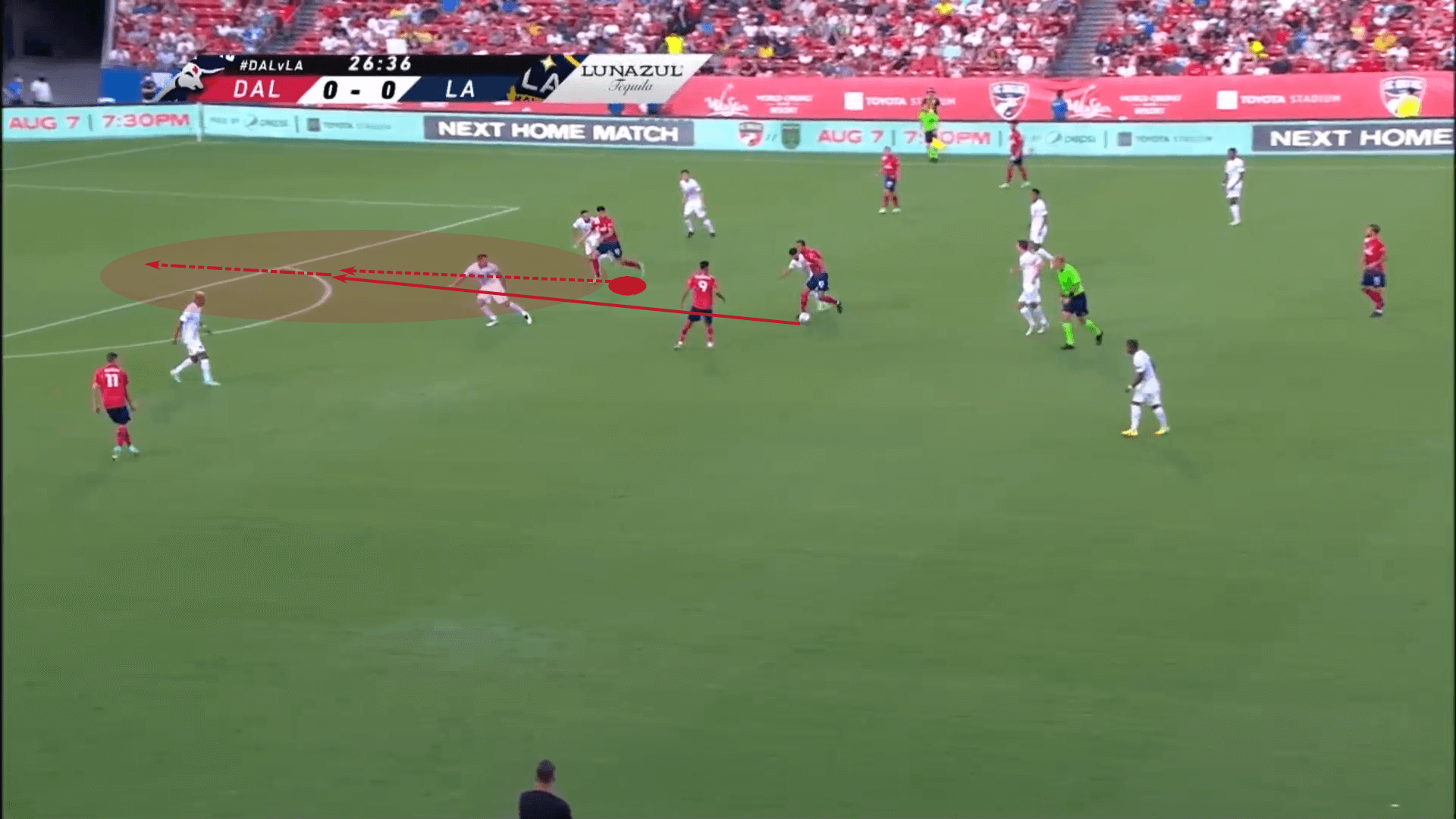
That’s exactly what’s happening in the sequence. His run starts from midfield. As he lays a ball off, he makes his run higher up the pitch, attacking the LA Galaxy’s left half-space. Pepi times his run well and latches onto a perfectly weighted pass, finishing the attack with a goal.
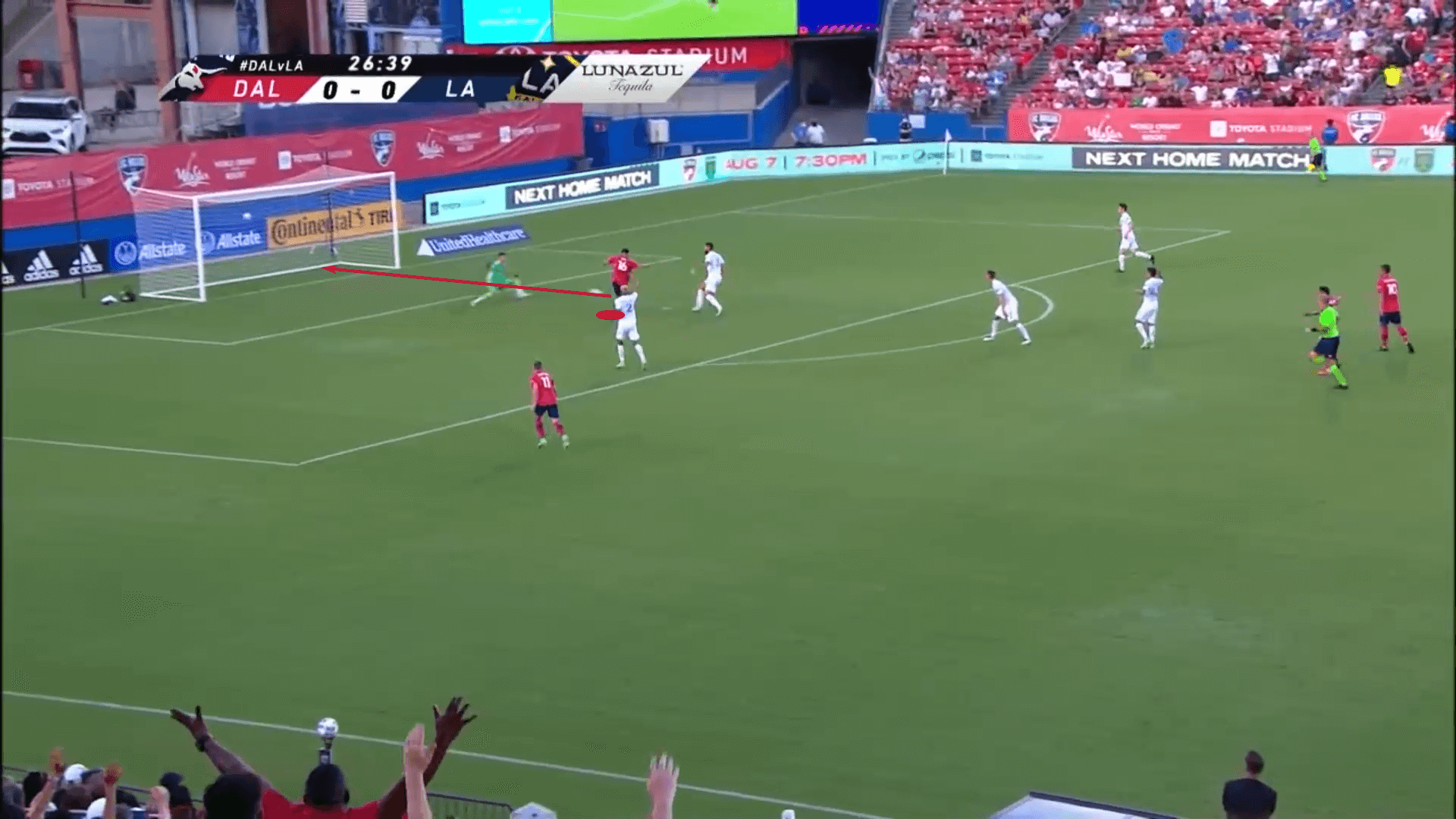
Just look at the separation he has created from the defence.
He’s a willing runner that is constantly on the lookout for gaps in the opposition’s backline. When he’s at his best, you’ll find Pepi bursting through those gaps leading a move to goal. In the best-case scenario, you’ll also have the ball at his feet when it’s time to release the shot.
Direct attacking
Building off of the previous section, we find a young, direct player who has made a remarkable transition from the academy to the first team. That transfer of tactics from the FC Dallas youth ranks has suited him well, allowing Pepi to make an instant impact in his second full season with the first team. At the time of writing, he leads the team in scoring with nine goals, triple the tally of the next leading scorers. In fact, he’s tied for 7th in the league with Nani, one goal ahead of the likes of Gonzalo Higuain and Alan Pulido.
Pepi fills the tactical demands of the FC Dallas #9 perfectly. The team organizes their tactics around high and medium recoveries, then punish the opposition with direct attacks to goal. In the typical Dallas attack, you’ll see the forwards in a forward-facing body orientation. Rather than playing into the highest line then setting back into midfield, the objective is to strike before the opposition can get numbers behind the ball and regain their defensive structure.
The sequence from the last section showed Pepi taking his first touch between the gaps in the Los Angeles Galaxy backline, but with his willingness to stretch the pitch vertically and his excellent starting positions, making him more difficult to track his initial steps, Dallas will look to play through passes into the path of Pepi, as well as over the top.
Against Sporting Kansas City, Dallas did well to disconnect the backline, drawing the right-back behind the three remaining defenders. With those extra meters of space, Pepi burst into action, latching onto a ball played over the top.
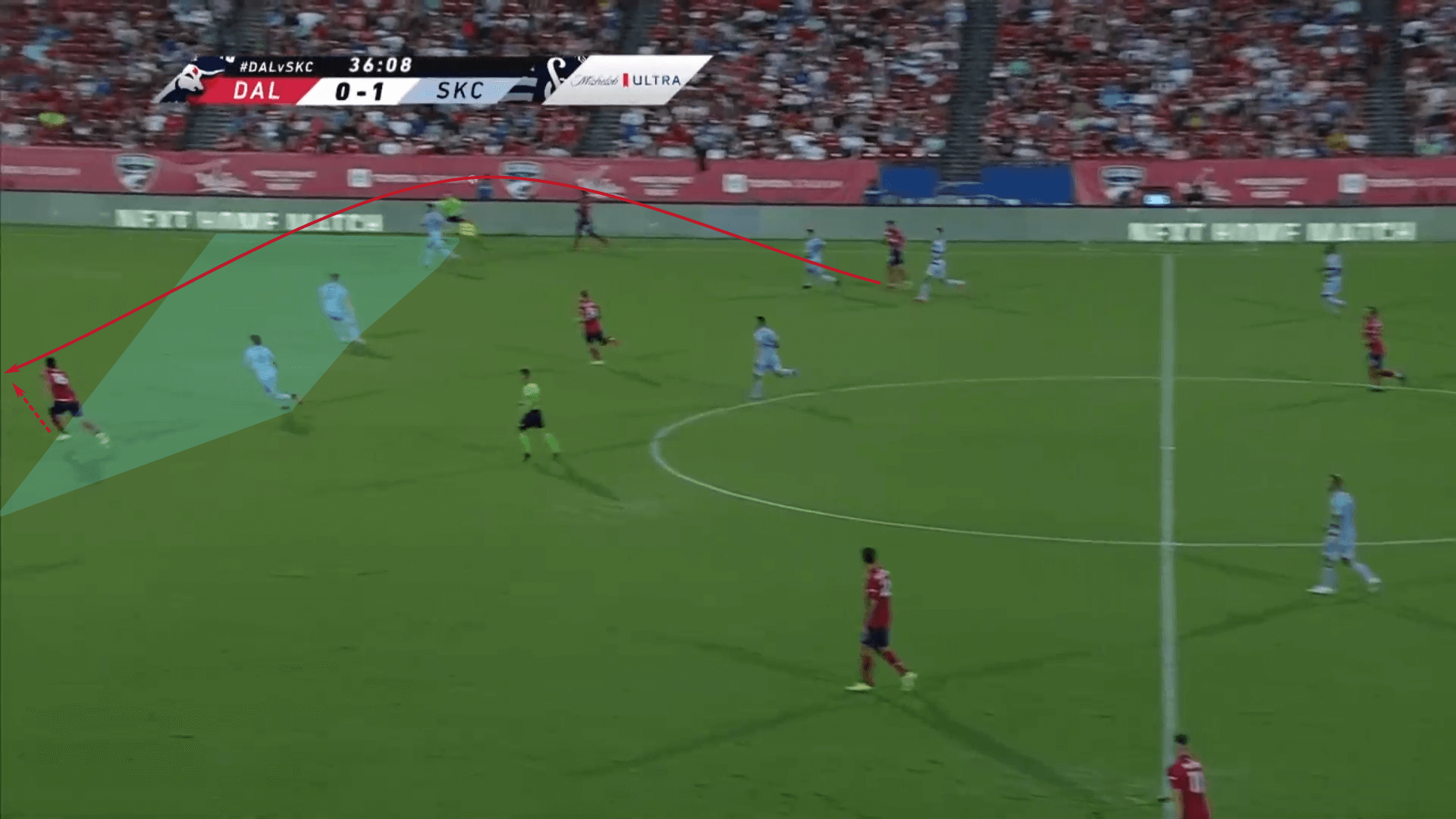
Even when he has dropped deeper into midfield, the objectives are clear: 1) draw a centreback higher up the pitch and 2) burst into gaps in the backline from a deeper, untracked position.
We saw an example of this later in the Kansas City game. Pepi first played his pass into the feet of Ferreira.
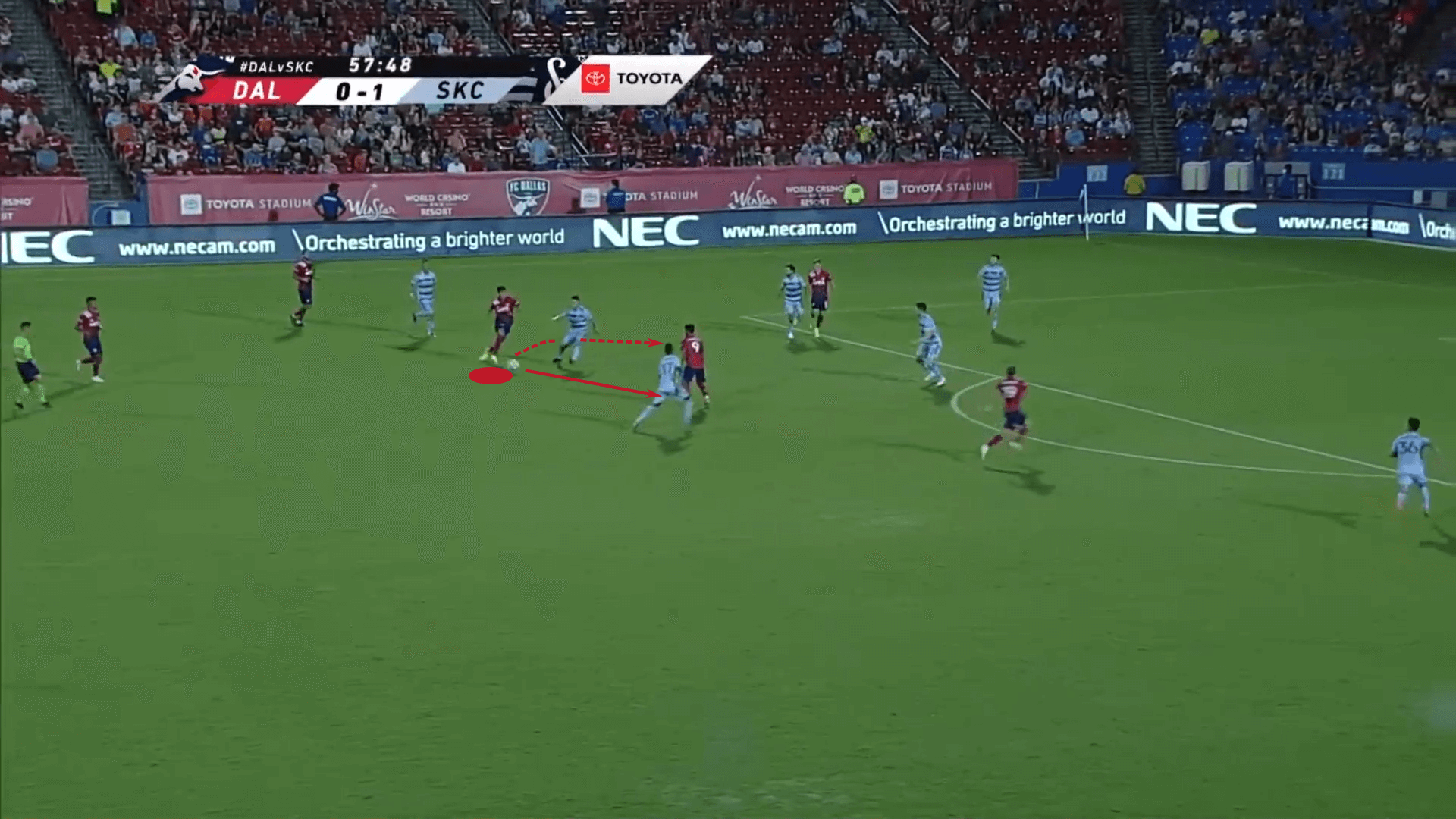
A give and go played Pepi into that tight space between the four defenders. As that pocket collapsed, he managed to squeeze a ball through them into the path of Paxton Pomykal, whose first touch sent him through to goal.
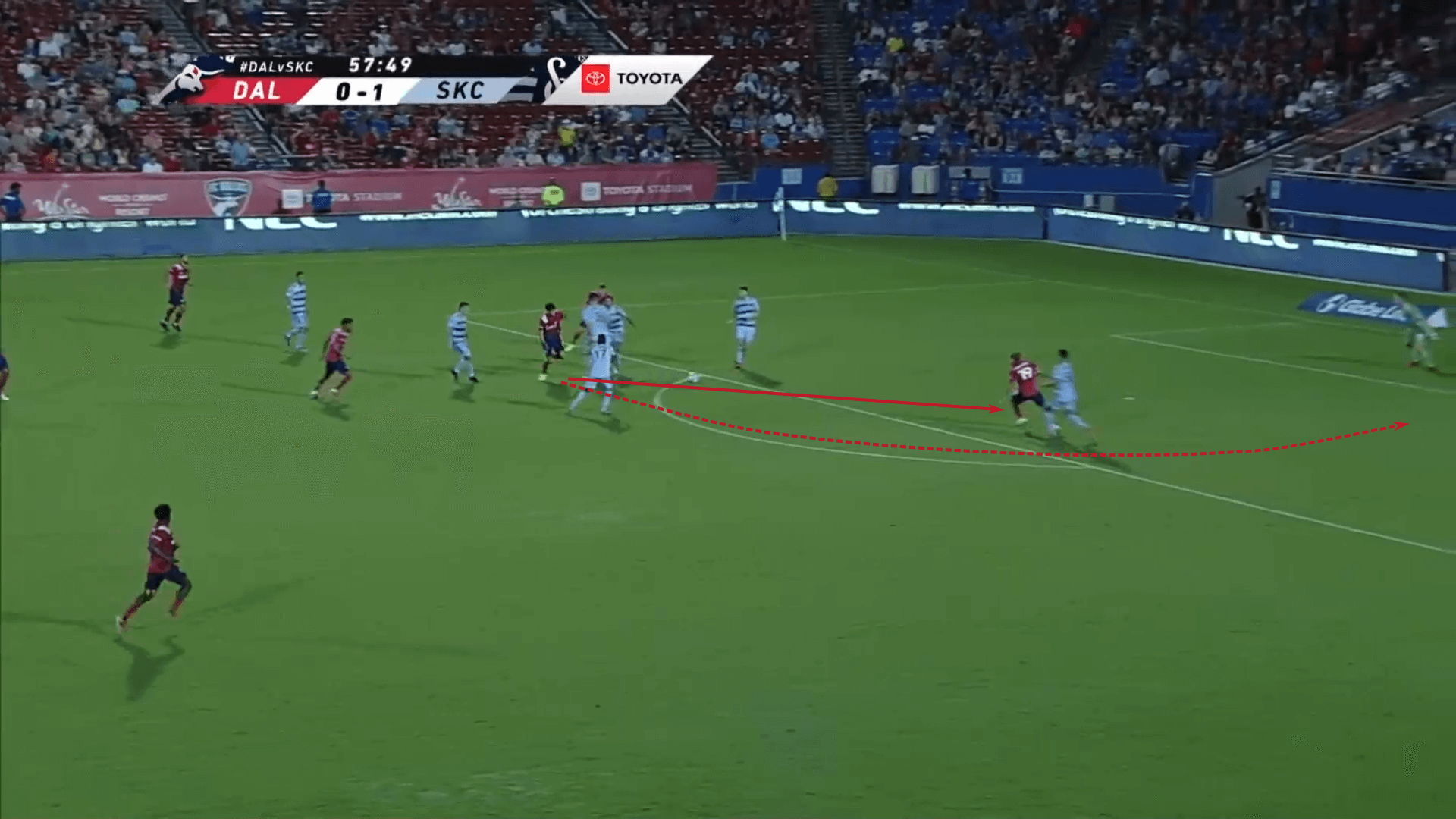
But Pomykal wasn’t able to finish, taking the ball to the goalkeeper’s right. Pepi continued his run to the back post, watching a shot clank off the crossbar, then nearly into his path. If not for some excellent last-ditch defending, Pepi’s forward-thinking run to the back post would have knotted the game at one.
The three match examples have shown how direct the Dallas attack is when in possession. Their attacking moves are quick and controlled, looking to break lines as quickly as possible as they make their move towards goal. They’re an excellent example of direct possession tactics.
Off the ball movement
Pepi’s willingness to attack the space behind the opposition’s backline is exactly what FC Dallas needs in a #9. The timing of his runs and his identification of gaps in the opposition’s line are the keys to his success.
When he’s at his best, he’s receiving service from his teammates higher up the pitch. If his teammates can receive between the opponent’s midfield and backline, Luchi’s tactics lead them to take a positive first touch and run at the opposition’s backline. If that aggressive approach can pull one member of the backline forward, Pepi takes the cue and runs into the space they have vacated.
Against the New England Revolution, Pepi had moved into a deeper position, allowing his right-sided teammate, Ferreira, to offer height in the team’s attacking shape. As Ferreira dropped into midfield to receive, a Revolution defender stepped forward into a first defender role. As he stepped forward, Pepi sprinted into the newly available space. His reaction was so quick that he gained three or four yards on his defender. Once Ferreira took his touch around the defender, his simple pass forward sent the 18-year-old through to goal.
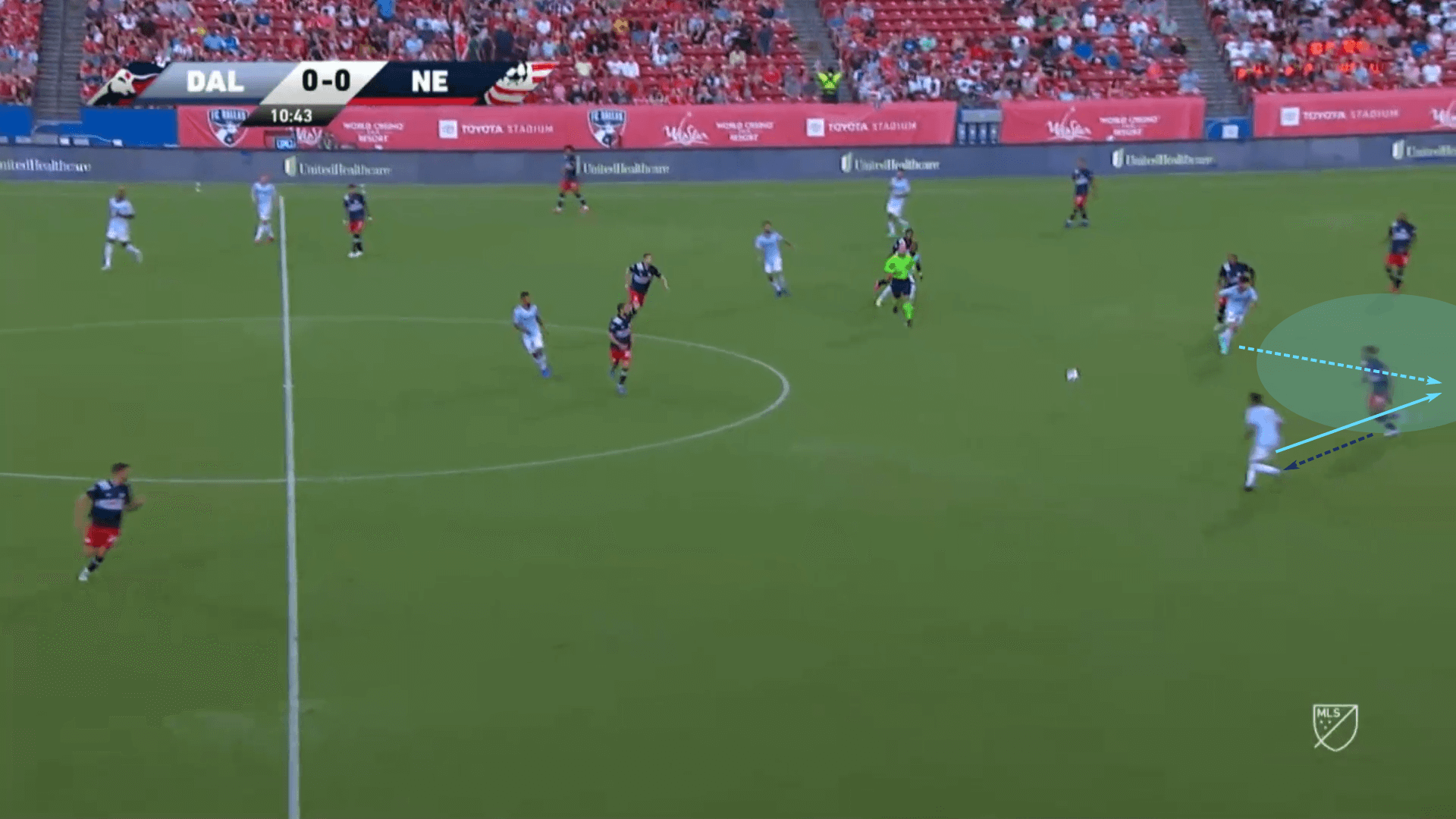
Pepi tapped into his clinical finishing to earn a goal on the play, but one thing to highlight is the massive amount of space between the three nearest defenders. Not only is there a lot of space, but their general shape was destroyed by Dallas’ off the ball movement.
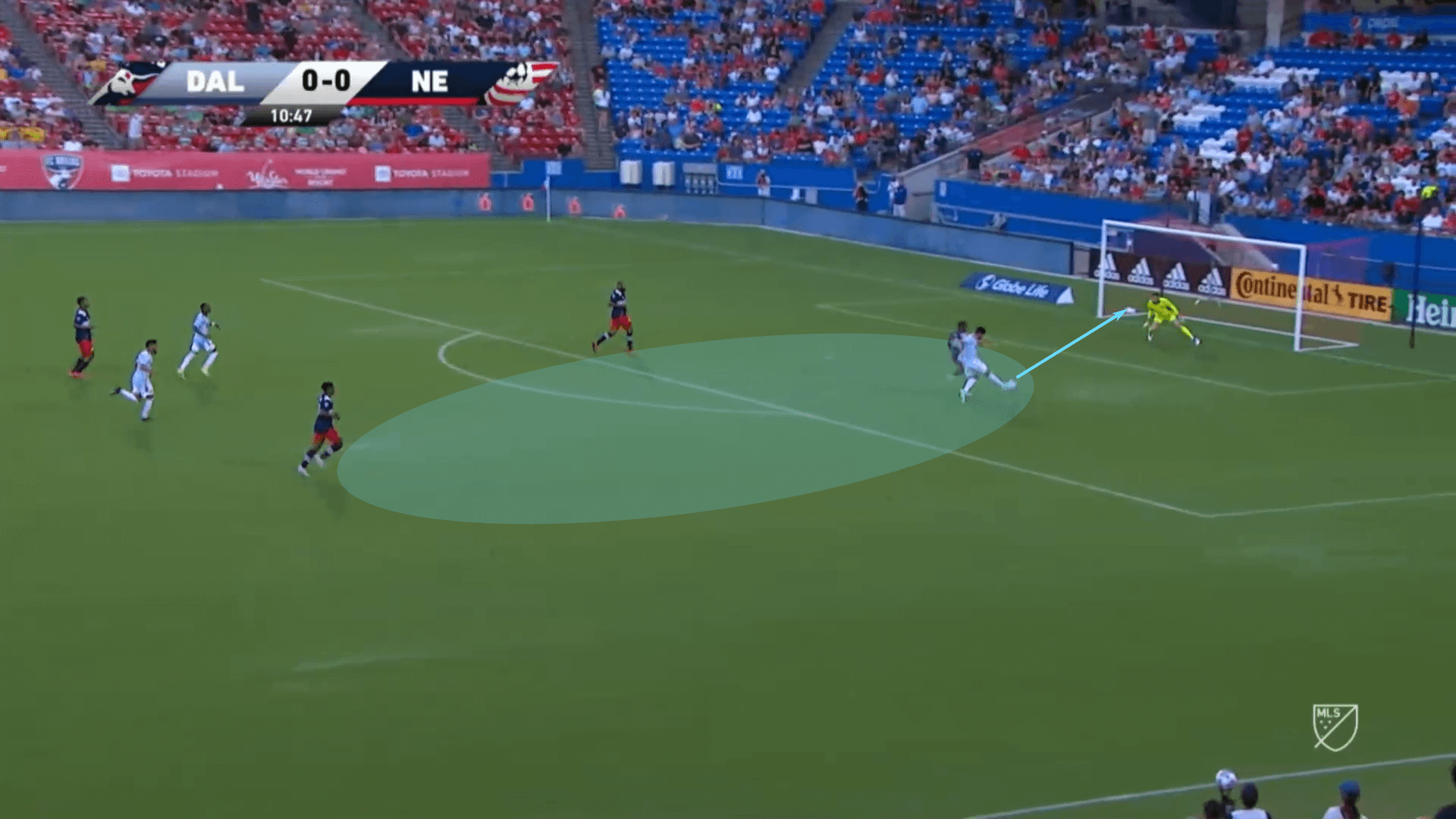
His movement off the ball positions him to receive while facing forward and attack a defender who is making a recovery run. That’s where Pepi’s intelligence and trickery kick in.
There’s perhaps no better example than his second goal against New England.
As the New England right-back stepped forward, Pepi made his run from the left half-space to the left-wing. Jon Bell closed down his space well and anticipated a forward touch by the teenager. Bell extended his left leg in an attempt to poke the ball out for a throw-in, but Pepi’s quick footwork saw him nutmeg his opponent then race through to goal.
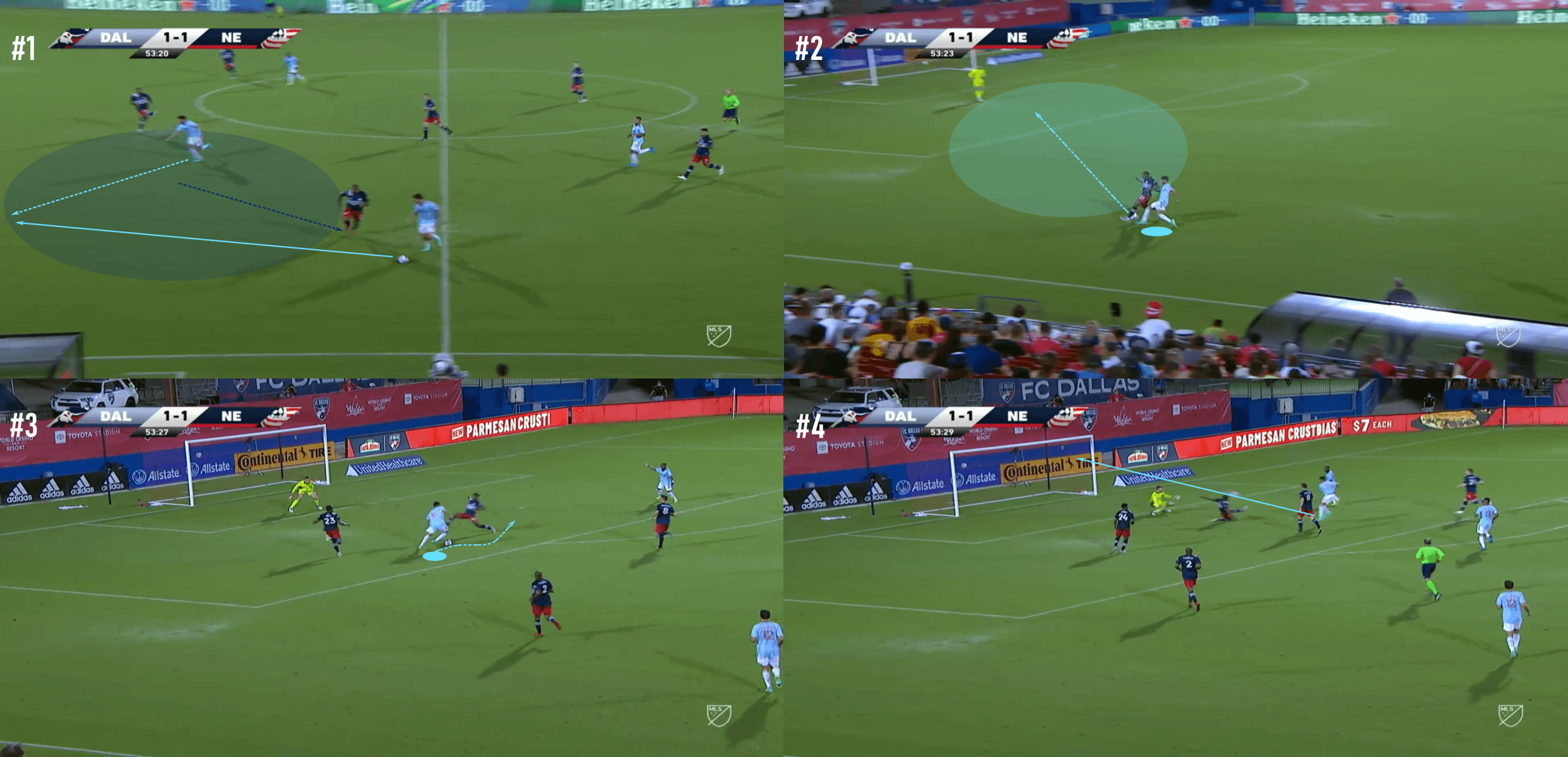
Pepi entered the box on his preferred right foot, setting up for the finish. Under the impression that the El Paso native would take a shot, New England’s left-back, DeJuan Jones, lunged forward in an attempted block. Another moment of individual brilliance and deception saw Pepi touch the ball to his right. Upon reaching the centre of the box, he finished off his extraordinary individual display to earn his highlight-reel goal.
When Pepi is at his best, his direct, vertical runs are fed by his teammates. Then, once isolated against a scrambling defender, Pepi has the intelligence and individual ability to beat a man and wreak havoc as Dallas make their move to goal.
Conclusion
Though he’s still a young player with room to grow in the game, this analysis highlights how lethal Pepi is in front of goal and the clever, direct movements he makes to get there. As the season progresses, which currently sees FC Dallas sitting outside of a playoff spot, look for opponents to place an added emphasis on negating Pepi’s influence.
This is an important stage in his career. Now that he’s made an initial, very positive impact, opponents are adjusting their tactics to defend against his runs into space. When the opposition is successful, one of the things that they’re doing well is denying that entry pass into Pepi, starving him of service.
But they are also tracking him much closer. After his hat trick against the LA Galaxy, he had gone six games without a goal before scoring against Houston. Opponents are adjusting and so must Pepi.
Even with the recent scoring slump, Pepi has shown why he is rightfully considered one of the brightest young stars in the league. FC Dallas have a long-standing tradition of producing top American talent. Pepi’s emergence at the age of 18 is the latest accomplishment from arguably America’s top football academy.

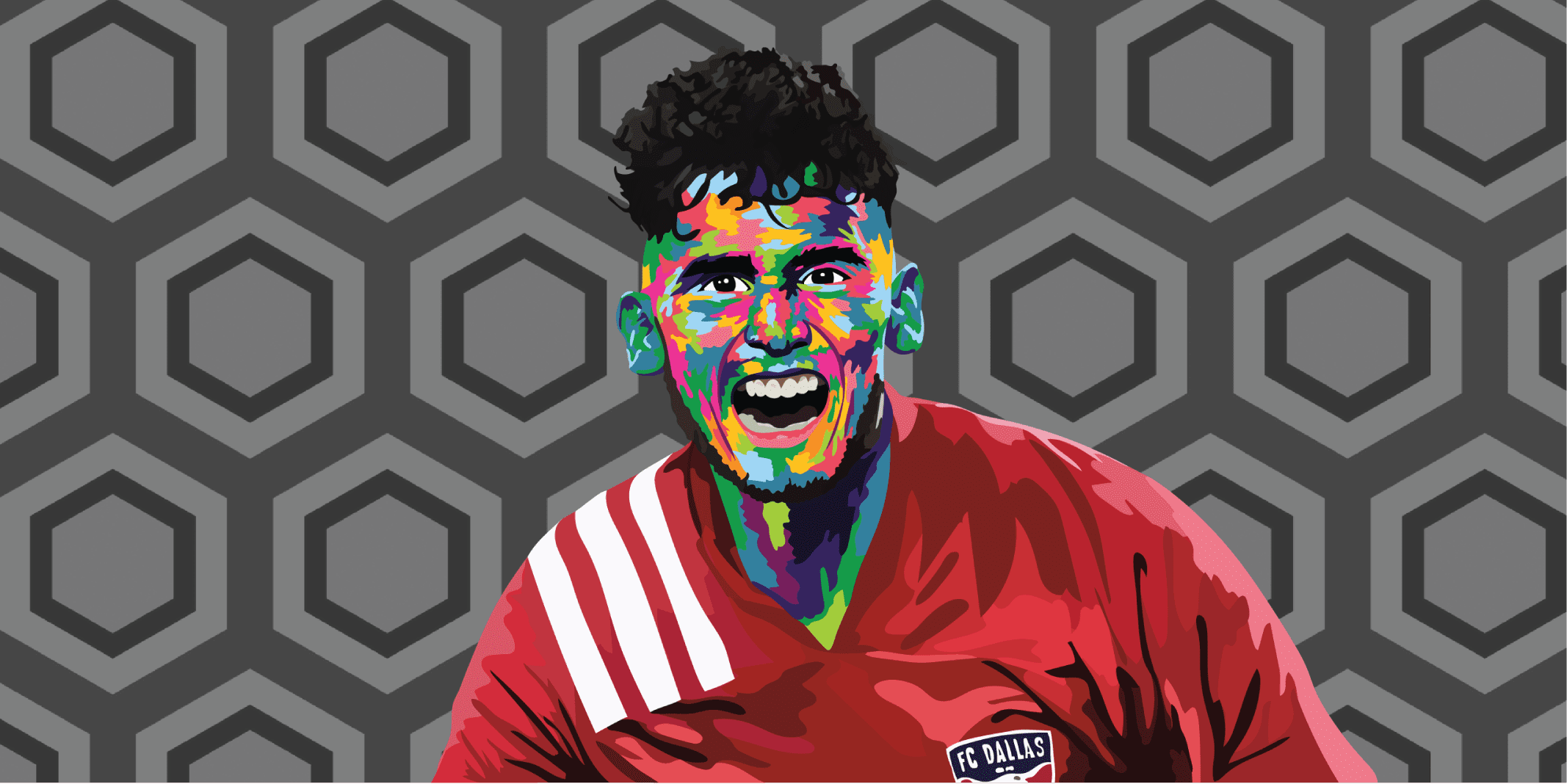



Comments